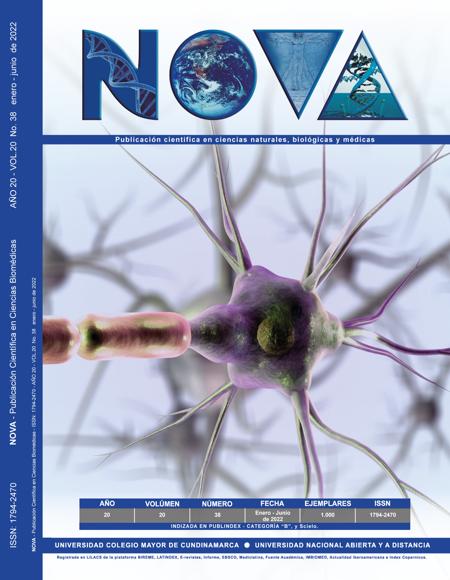EFECTO DEL FACTOR DE CRECIMIENTO FIBROBLÁSTICO DOS EN LA REDUCCIÓN DE LA SENESCENCIA EN CÉLULAS MADRE MESENQUIMALES AISLADAS DE GELATINA DE WHARTON
FIBROBLASTIC GROWTH FACTOR TWO REDUCES THE SENESCENT EFFECT ON MESENCHYMAL STEM CELL ISOLATED FROM WHARTON´S JELLY.

NOVA por http://www.unicolmayor.edu.co/publicaciones/index.php/nova se distribuye bajo una Licencia Creative Commons Atribución-NoComercial-SinDerivar 4.0 Internacional.
Así mismo, los autores mantienen sus derechos de propiedad intelectual sobre los artículos.
Mostrar biografía de los autores
Las células madre mesenquimales han generado interés en la ingeniería de tejidos, debido a sus propiedades proliferativas y capacidad de reparación de tejidos, sin embargo, para un trasplante exitoso, es necesario aumentar el número de células mediante un cultivo in-vitro. Durante este proceso la capacidad proliferativa disminuye, provocando cambios en la morfología y funcionalidad celular y afectando la viabilidad del cultivo, este estado se conoce como senescencia celular y como posibles causales, se ha considerado el estrés oxidativo y la falta de factores de crecimiento. Con el objetivo de evaluar el efecto de FGF-2 sobre la senescencia de un cultivo de células madre mesenquimales aisladas de gelatina de Wharton y su papel en la regulación del estrés oxidativo se añadieron dosis de 3,5 y 7,5 ng de FGF-2 al cultivo. Durante los pasajes 5 y 7, se estimó tanto la senescencia celular como la presencia de ROS (especies reactivas de oxígeno). Como resultado se obtuvo en el pasaje 5, una diferencia significativa del 99,5% entre el control (+) con respecto a los tratamientos con FGF-2, sin embargo, en el pasaje 7 se observó un aumento en la producción de la enzima β-galactosidasa y cambios morfológicos, confirmando un estado senescente en el cultivo en todos los tratamientos evaluados. En conclusión, las dosis utilizadas en este estudio contribuyeron positivamente a disminuir el proceso senescente en el cultivo celular, además se determinó, que el FGF-2 puede prolongar el tiempo de cultivo, retardando parcialmente la concentración de especies reactivas de oxígeno.
Visitas del artículo 197 | Visitas PDF 115
Descargas
- Y. B. Cui et al., "Human umbilical cord mesenchymal stem cells transplantation improves cognitive function in Alzheimer's disease mice by decreasing oxidative stress and promoting hippocampal neurogenesis," Behav. Brain Res., vol. 320, 2017, doi: 10.1016/j.bbr.2016.12.021. https://doi.org/10.1016/j.bbr.2016.12.021
- J. Vasanthan et al., "Role of Human Mesenchymal Stem Cells in Regenerative Therapy," Cells, vol. 10, no. 1. 2020, doi: 10.3390/cells10010054. https://doi.org/10.3390/cells10010054
- R. Yonemitsu et al., "Fibroblast Growth Factor 2 Enhances Tendon-to-Bone Healing in a Rat Rotator Cuff Repair of Chronic Tears," Am. J. Sports Med., vol. 47, no. 7, 2019, doi: 10.1177/0363546519836959. https://doi.org/10.1177/0363546519836959
- A. Aghajani Nargesi, L. O Lerman, and A. Eirin, "Mesenchymal stem cell-derived extracellular vesicles for renal repair," Curr. Gene Ther., vol. 17, no. 1, pp. 29-42, 2017. https://doi.org/10.2174/1566523217666170412110724
- B. Badyra, M. Sułkowski, O. Milczarek, and M. Majka, "Mesenchymal stem cells as a multimodal treatment for nervous system diseases," Stem Cells Translational Medicine, vol. 9, no. 10. 2020, doi: 10.1002/sctm.19-0430.
- https://doi.org/10.1002/sctm.19-0430
- G. Z. Salazar Vargas, V. M. Neyra Chagua, C. R. Pitot Álvarez, A. M. Muñoz Jáuregui, and L. Á. Aguilar Mendoza, "Estudios en neurociencias: aportes para la investigación en cultivo de células madre mesenquimales," Persona, no. 21, 2018. https://doi.org/10.26439/persona2018.n021.1993
- J. A. Guadix, J. L. Zugaza, and P. Gálvez-Martín, "Características, aplicaciones y perspectivas de las células madre mesenquimales en terapia celular," Medicina Clinica, vol. 148, no. 9. 2017, doi: 10.1016/j.medcli.2016.11.033. https://doi.org/10.1016/j.medcli.2016.11.033
- Kobolak J, Dinnyes A, Memic A, Khademhosseini A, Mobasheri A. Mesenchymal stem cells: Identification, phenotypic characterization, biological properties and potential for regenerative medicine through biomaterial micro-engineering of their niche. Methods. 2016 Apr 15;99:62-8. doi: 10.1016/j.ymeth.2015.09.016. Epub 2015 Sep 15. PMID: 26384580. https://doi.org/10.1016/j.ymeth.2015.09.016
- M. Kosinski et al., "Bone Defect Repair Using a Bone Substitute Supported by Mesenchymal Stem Cells Derived from the Umbilical Cord," Stem Cells Int., vol. 2020, 2020, doi: 10.1155/2020/1321283.
- https://doi.org/10.1155/2020/1321283
- A. Can, F. T. Celikkan, and O. Cinar, "Umbilical cord mesenchymal stromal cell transplantations: a systemic analysis of clinical trials," Cytotherapy, vol. 19, no. 12, pp. 1351-1382, 2017. https://doi.org/10.1016/j.jcyt.2017.08.004
- M. Ziaei, J. Zhang, D. V Patel, and C. N. J. McGhee, "Umbilical cord stem cells in the treatment of corneal disease," Surv. Ophthalmol., vol. 62, no. 6, pp. 803-815, 2017. https://doi.org/10.1016/j.survophthal.2017.02.002
- S. Roy, S. Arora, P. Kumari, and M. Ta, "A simple and serum-free protocol for cryopreservation of human umbilical cord as source of Wharton's jelly mesenchymal stem cells," Cryobiology, vol. 68, no. 3, 2014, doi: 10.1016/j.cryobiol.2014.03.010. https://doi.org/10.1016/j.cryobiol.2014.03.010
- A. C. Schnitzler et al., "Bioprocessing of human mesenchymal stem/stromal cells for therapeutic use: current technologies and challenges," Biochem. Eng. J., vol. 108, pp. 3-13, 2016. https://doi.org/10.1016/j.bej.2015.08.014
- S. Ramos García, "Células madre: potencial asombroso, desafiante demanda," 2014.
- Y. W. Eom et al., "The role of growth factors in maintenance of stemness in bone marrow-derived mesenchymal stem cells," Biochem. Biophys. Res. Commun., vol. 445, no. 1, pp. 16-22, 2014. https://doi.org/10.1016/j.bbrc.2014.01.084
- S. H. Hong et al., "Stem cell passage affects directional migration of stem cells in electrotaxis," Stem Cell Res., vol. 38, p. 101475, 2019. https://doi.org/10.1016/j.scr.2019.101475
- C. Rubio-Vargas, J. Alcázar, and L. Francis-Turner, "Influencia del factor de crecimiento fibroblástico 2 en células madre in vitro Estudio de revisión.," Actual. Biológicas, vol. 41, no. 110, 2019. https://doi.org/10.17533/udea.acbi.v41n111a03
- W. Wei and S. Ji, "Cellular senescence: molecular mechanisms and pathogenicity," J. Cell. Physiol., vol. 233, no. 12, pp. 9121-9135, 2018. https://doi.org/10.1002/jcp.26956
- V. Turinetto, E. Vitale, and C. Giachino, "Senescence in human mesenchymal stem cells: functional changes and implications in stem cell-based therapy," Int. J. Mol. Sci., vol. 17, no. 7, p. 1164, 2016.
- https://doi.org/10.3390/ijms17071164
- L. Chuaire-Noack, C. García-Morcote, and S. R. Ramírez-Clavijo, "Actividad β-galactosidasa asociada con la senescenciChuaire-Noack, L., García-Morcote, C., & Ramírez-Clavijo, S. R. (2011). Actividad β-galactosidasa asociada con la senescencia en fibroblastos del estroma ovárico in vitro. Revista Ciencias de La Salud, 9," Rev. Ciencias la Salud, vol. 9, no. 1, pp. 17-31, 2011.
- S. Saez-Atienzar and E. Masliah, "Cellular senescence and Alzheimer disease: the egg and the chicken scenario," Nature Reviews Neuroscience, vol. 21, no. 8. 2020, doi: 10.1038/s41583-020-0325-z.
- https://doi.org/10.1038/s41583-020-0325-z
- K. Endo, N. Fujita, T. Nakagawa, and R. Nishimura, "Effect of fibroblast growth factor-2 and serum on canine mesenchymal stem cell chondrogenesis," Tissue Eng. Part A, vol. 25, no. 11-12, pp. 901-910, 2019.
- https://doi.org/10.1089/ten.tea.2018.0177
- Y. Zou, H. J. Tong, M. Li, K. S. Tan, and T. Cao, "Telomere length is regulated by FGF-2 in human embryonic stem cells and affects the life span of its differentiated progenies," Biogerontology, vol. 18, no. 1, pp. 69-84, 2017.
- https://doi.org/10.1007/s10522-016-9662-8
- F. Kottakis, C. Polytarchou, P. Foltopoulou, I. Sanidas, S. C. Kampranis, and P. N. Tsichlis, "FGF-2 Regulates Cell Proliferation, Migration, and Angiogenesis through an NDY1/KDM2B-miR-101-EZH2 Pathway," Mol. Cell, vol. 43, no. 2, 2011, doi: 10.1016/j.molcel.2011.06.020. https://doi.org/10.1016/j.molcel.2011.06.020
- T. Ito, R. Sawada, Y. Fujiwara, Y. Seyama, and T. Tsuchiya, "FGF-2 suppresses cellular senescence of human mesenchymal stem cells by down-regulation of TGF-β2," Biochem. Biophys. Res. Commun., vol. 359, no. 1, pp. 108-114, 2007. https://doi.org/10.1016/j.bbrc.2007.05.067
- L. M. de Souza, "Avaliação da indução de senescência e apoptose pelo tratamento com antraciclinas em fibroblastos humanos deficientes no reparo por excisão de nucleotídeos," 2011.
- M. Liu et al., "Adipose-derived mesenchymal stem cells from the elderly exhibit decreased migration and differentiation abilities with senescent properties," Cell Transplant., vol. 26, no. 9, pp. 1505-1519, 2017.
- https://doi.org/10.1177/0963689717721221
- W. Zhai et al., "Identification of senescent cells in multipotent mesenchymal stromal cell cultures: Current methods and future directions," Cytotherapy, vol. 21, no. 8. 2019, doi: 10.1016/j.jcyt.2019.05.001.
- https://doi.org/10.1016/j.jcyt.2019.05.001
- X. Meng, M. Xue, P. Xu, F. Hu, B. Sun, and Z. Xiao, "MicroRNA profiling analysis revealed different cellular senescence mechanisms in human mesenchymal stem cells derived from different origin," Genomics, vol. 109, no. 3-4, 2017, doi: 10.1016/j.ygeno.2017.02.003. https://doi.org/10.1016/j.ygeno.2017.02.003
- J. Franzen et al., "Senescence-associated DNA methylation is stochastically acquired in subpopulations of mesenchymal stem cells," Aging Cell, vol. 16, no. 1, 2017, doi: 10.1111/acel.12544. https://doi.org/10.1111/acel.12544
- J. A. Arévalo Romero, D. Páez Guerrero, and V. M. Rodríguez Pardo, "Evaluación de características morfológicas e inmunofenotipo de células madre mesenquimales en cultivo obtenidas a partir de sangre de cordón umbilical y médula ósea.," Nova, vol. 5, no. 8, 2007, doi: 10.22490/24629448.380.
- https://doi.org/10.22490/24629448.380
- I. Fridlyanskaya, L. Alekseenko, and N. Nikolsky, "Senescence as a general cellular response to stress: a mini-review," Exp. Gerontol., vol. 72, pp. 124-128, 2015. https://doi.org/10.1016/j.exger.2015.09.021
- R. A. Avelar et al., "A multidimensional systems biology analysis of cellular senescence in aging and disease," Genome Biol., vol. 21, no. 1, 2020, doi: 10.1186/s13059-020-01990-9. https://doi.org/10.1186/s13059-020-01990-9
- D. N. Gala and Z. Fabian, "To Breathe or Not to Breathe: The Role of Oxygen in Bone Marrow-Derived Mesenchymal Stromal Cell Senescence," Stem Cells Int., vol. 2021, p. 8899756, 2021, doi: 10.1155/2021/8899756.
- https://doi.org/10.1155/2021/8899756
- J. Li et al., "Down-regulation of fibroblast growth factor 2 (FGF2) contributes to the premature senescence of mouse embryonic fibroblast," Med. Sci. Monit., vol. 26, 2020, doi: 10.12659/MSM.920520.
- https://doi.org/10.12659/MSM.920520
- U. Galderisi et al., "Efficient cultivation of neural stem cells with controlled delivery of FGF-2," Stem Cell Res., vol. 10, no. 1, 2013, doi: 10.1016/j.scr.2012.09.001. https://doi.org/10.1016/j.scr.2012.09.001
- A. Cieślar-Pobuda, J. Yue, H.-C. Lee, M. Skonieczna, and Y.-H. Wei, "ROS and oxidative stress in stem cells." Hindawi, 2017. https://doi.org/10.1155/2017/5047168
- R. A. Denu and P. Hematti, "Effects of oxidative stress on mesenchymal stem cell biology," Oxid. Med. Cell. Longev., vol. 2016, 2016. https://doi.org/10.1155/2016/2989076
- C. L. Bigarella, R. Liang, and S. Ghaffari, "Stem cells and the impact of ROS signaling," Development, vol. 141, no. 22, pp. 4206-4218, 2014. https://doi.org/10.1242/dev.107086
- Y. Liu and Q. Chen, "Senescent Mesenchymal Stem Cells: Disease Mechanism and Treatment Strategy," Curr. Mol. Biol. Reports, vol. 6, no. 4, 2020, doi: 10.1007/s40610-020-00141-0. https://doi.org/10.1007/s40610-020-00141-0
- T. Kamiya, M. Courtney, and M. O. Laukkanen, "Redox-activated signal transduction pathways mediating cellular functions in inflammation, differentiation, degeneration, transformation, and death." Hindawi, 2016.
- https://doi.org/10.1155/2016/8479718





